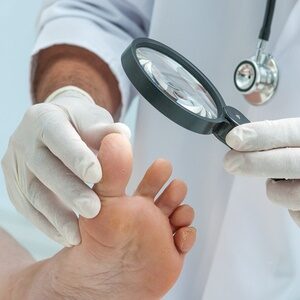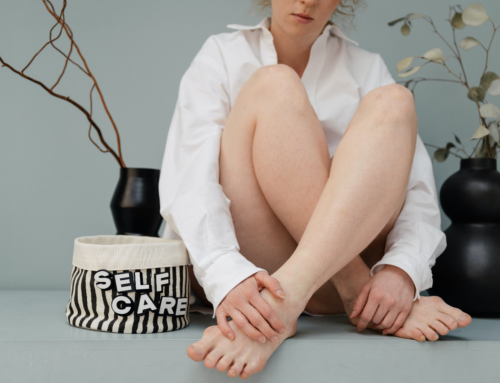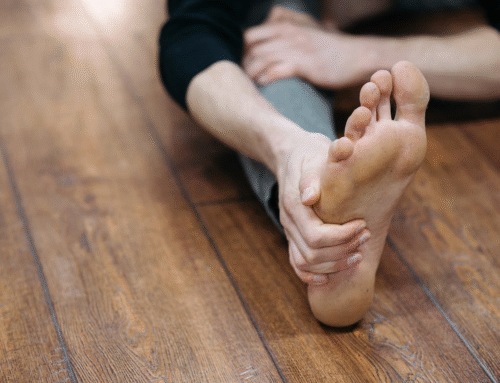Bleach and other fungus “treatments” can be harmful. Bleach is a harsh chemical cleaning product recommended for disinfecting surfaces, such as in bathrooms. Some websites recommend using bleach to treat toenail fungus. The use of bleach on toenail fungus is one of many “home remedies” for fungus recommended online. These are all very ineffective and most likely will not give you the results you desire.
While at home, DIY treatments for toenail fungus aren’t effective; some of them are worse ideas than others. Bleach is one of the worst of these because it comes with many downsides and negative effects as well.
Why not use bleach as a treatment option
The recommendation to use bleach on your toenails should be something that makes you take a second look at sources you find on the internet. Bleach is a chemical cleaning product and not a medical treatment.
In fact, using bleach on the skin can cause serious damage to the tissue. This is why the label on the package warns against getting the chemical on your skin. Putting bleach on your toe is likely to irritate the skin more and could cause more serious health concerns.
Common symptoms of chemical burns include redness, irritation, burning, and pain. Also, when chemical burns are more severe, they can cause blistering, numbness, and in very severe situations, even systemic issues. Systemic symptoms from chemical burns occur when the chemical gets into the bloodstream. When this happens, cough, shortness of breath, low blood pressure, headache, muscle twitching, and seizures, among others, are possible symptoms.

Side Effects of Bleach
The use of bleach can actually cause infections if you pour it on your skin. It does this by burning the skin itself, which damages the protection it creates against infection. It makes sense that bleach will harm the skin because it is a chemical made for cleaning. Using cleaning products, which are harsh chemicals, against their intended use is ill-advised. In fact, even the fumes from bleach can be damaging to breathe in for too long, so direct contact with the skin is even more dangerous.
Bleach is not only dangerous for the skin, but it won’t solve the issue of toenail fungus. Even if the bleach is able to penetrate into the nail bed, it is ineffective at killing fungal spores. If you try this treatment at home, you are likely to be left with an irritated or burned toe and no results to show for it.
How to avoid bleach burns
If you have attempted using bleach as a treatment for toenail fungus, you may be experiencing pain and burning at the site of bleach application. In this circumstance, there are a few things you should do immediately. First and foremost, rinse the bleach off your skin immediately. This will prevent the damage the bleach is doing to the skin from continuing and becoming worse. You should rinse the area thoroughly with water that isn’t hot, since hot water can further the irritation and inflammation of the skin. Rinse thoroughly, then wash the skin with gentle hand soap. You can apply a cloth soaked in cool water or aloe vera to the burn on the skin, which should soothe any pain. Neosporin can also help the burn heal.
After you have washed the bleach off the skin, assess the damage done by the chemical. If you have applied undiluted bleach for any period of time, you are likely to have a bleach burn. Depending on the severity of the damage, you may require immediate attention from a medical professional. In this case, you should go to the emergency room to have them assess the damage done to your skin. If the irritation isn’t severe, you should bandage the skin and monitor if its condition progresses. Signs of a severe burn from a chemical like bleach include open wound formation, worsening with time, pulsating heat, red streaks forming around the burn, development of a fever, and signs of infection like pus drainage.
Dangers of Chemical Burns
To ensure bleach doesn’t cause a chemical burn, the best thing to do is not use bleach on the skin at all. Medical professionals would also suggest this due to the properties of bleach. By avoiding using bleach on the skin, it won’t have the opportunity to cause a chemical burn. However, if you do get some bleach on the skin, you should rinse it off immediately with water.
After rinsing it off, you can use soap and water to get rid of any residual bleach on your skin. After rinsing off the bleach, assess the damage done to your skin. If you have noticed symptoms of a moderate or severe chemical burn or if you are in pain, you should be seen by a medical professional immediately. Severe chemical burns are a medical emergency.
Reasons why bleach is not a safe treatment
Bleach treatment for nail fungus is not the answer for people struggling with nail fungus. Applying bleach to the skin is likely to result in damage to the nail or toe itself. Whether in the form of chemical burns, irritation, inflammation, or even another infection. The risk of damage from bleach is very high. It is important to read the safety precautions on the bottle of bleach to avoid serious harm.
Bleach treatment for nail fungus is also ineffective at killing fungal spores, because it doesn’t have antifungal properties. There are better treatments available for the fungus that are scientifically designed to target the fungus. Even antifungal topical medications that are made for the purpose are ineffective at curing this condition, so bleach is an even worse option.
Avoid Nail and Skin Damage
If any bleach comes into contact with your skin, to minimize the damage, you should immediately rinse off any bleach for at least 5 minutes or longer with running water. Immediately remove any clothing that could have come into contact with the chemical as well; these clothes could harbor residual chemicals that will cause further damage.
Rinse the area with water, followed by a very thorough wash with soap and water. After rinsing and washing off the bleach, dry off the area and take a look at the skin.
To assess the nail damage from bleach, you should first examine how the skin looks in the area that was in contact with the bleach. Chemical burns almost always require immediate medical attention.
However, if you only notice mild redness without any pain, you can wait to see if the condition gets better before seeing a medical professional. In the meantime, you can apply cool compresses and ointments to the burn to see if that helps with the symptoms. However, if the burns don’t get better quickly, you will need to seek medical attention as soon as possible.
Bleach DIYs
Bleach is sometimes recommended as an at-home treatment for toenail fungus. However, treatments of this nature are typically very ineffective. They are ineffective because they don’t utilize properly researched medicines or techniques, and aren’t done by medical professionals. All at-home treatments for toenail fungus are going to have very little effect. They aren’t as effective as proper medical care. For example, some internet blogs recommend using bleach on the toenail fungus. No nail doctor would ever recommend it. Using bleach on toenail fungus is discouraged by both nail doctors and bleach manufacturers.
Other DIY treatments
Bleach is also ineffective at treating the fungus itself. It is not a good antifungal agent, and it can’t properly penetrate through the nail into the nail bed where the fungus resides. This is similar to other DIY home treatment methods for fungus, like Vicks VapoRub. If you are set on trying to treat fungus at home, there are over-the-counter prescription creams that you can get to try to cure the fungus. However, these are very weak and could even take years to see any improvement at all, much less a fully cleared nail.
These are definitely a better option to try than bleach, however, since they are much less likely to cause a reaction. Any reaction caused by these products is caused by individual intolerance or allergy to the active ingredient, as compared to bleach, which will cause a reaction in everyone. Bleach and other fungus “treatments” can be harmful.

Recommended Treatments
Bleach and other fungus “treatments” can be harmful. Aside from bleach and other DIY home methods, there are prescription medications available for fungus as well. The best thing to do when trying to cure a fungus once and for all is to be seen by a licensed podiatrist, since they are doctors who specialize in treating issues with the feet. A podiatrist will be able to give you a treatment plan that is backed by science, and hopefully minimize negative effects from the treatment they prescribe.
Laser for Toenail Fungus
Aside from bleach removal, there are other options available for fungus removal. These are almost all much safer than using bleach. Also, most of them are more effective at curing the fungus. However, some still carry dangers with them. Oral medications for fungus can cause dangerous side effects, including liver toxicity. These medications, therefore, require blood work before and during the treatment and are not recommended for people who may have liver issues.
Bleach removal, oral medications, and topical medications alike can be ineffective at eliminating the fungus. A better option is laser treatment, specifically with the PinPointe laser at Laser Nail Therapy. The PinPointe Laser treatment has the highest cure rate in the market. It has no side effects and no recovery period. As a result, you can go about your daily activities right after the treatment. Also, it is not painful. To schedule a consultation, give us a call at 1-(800) 672-0625 or visit our website for more information.




